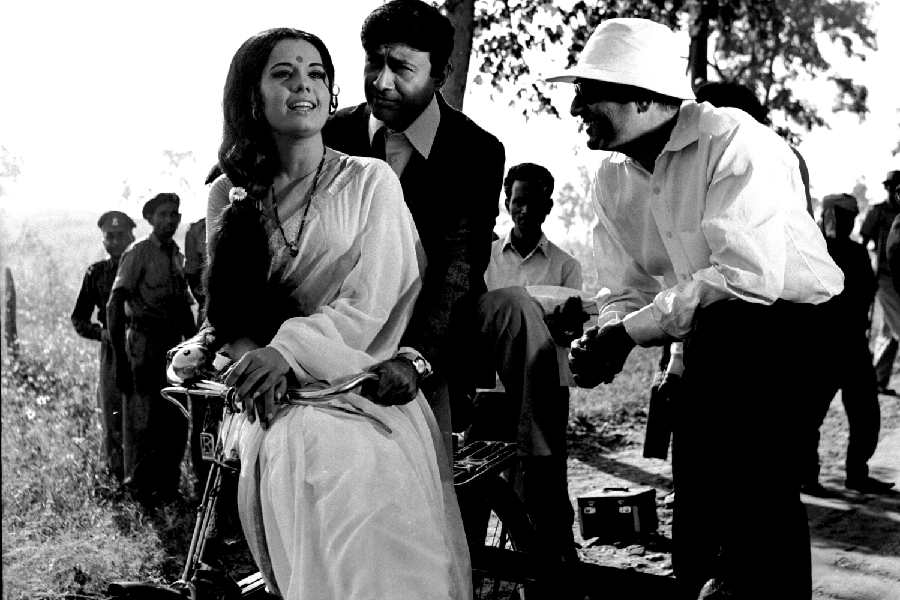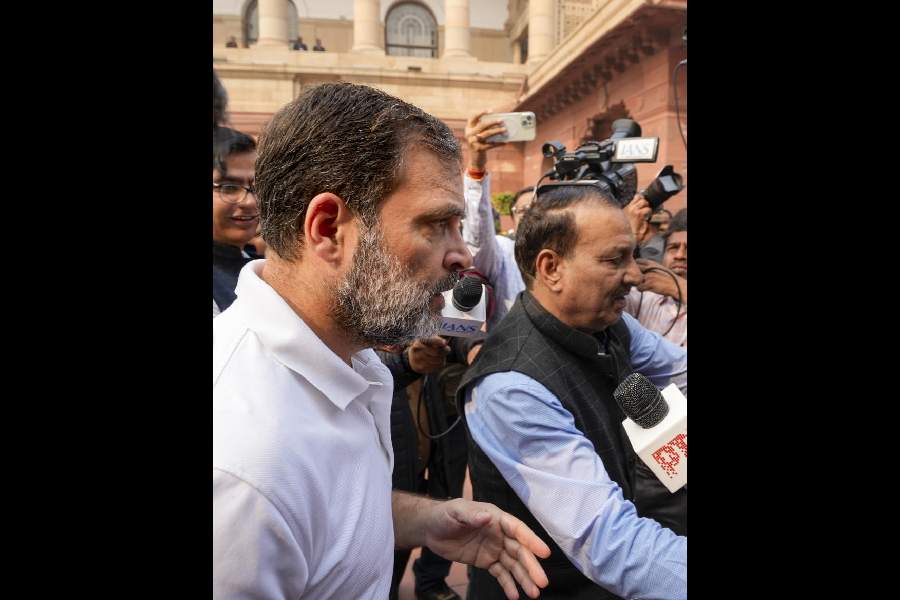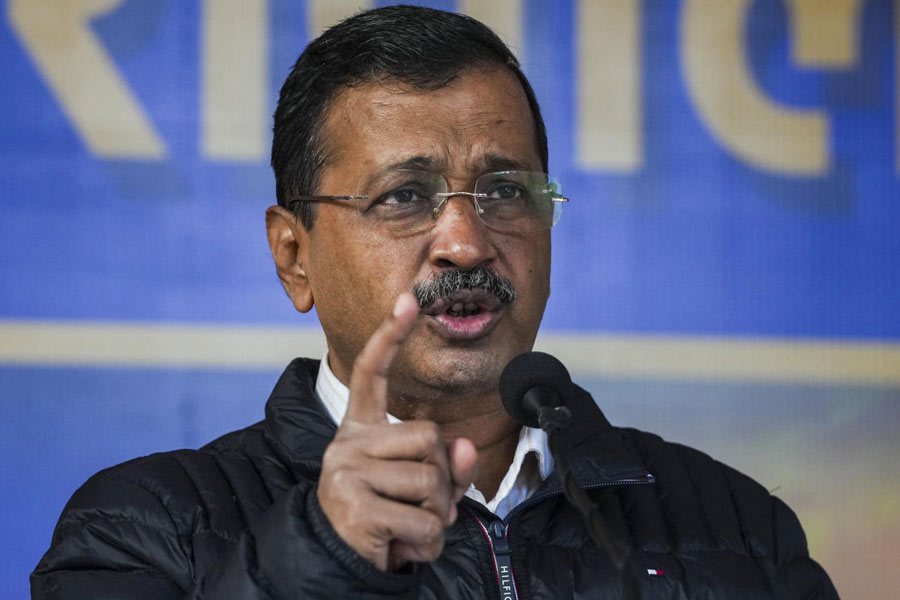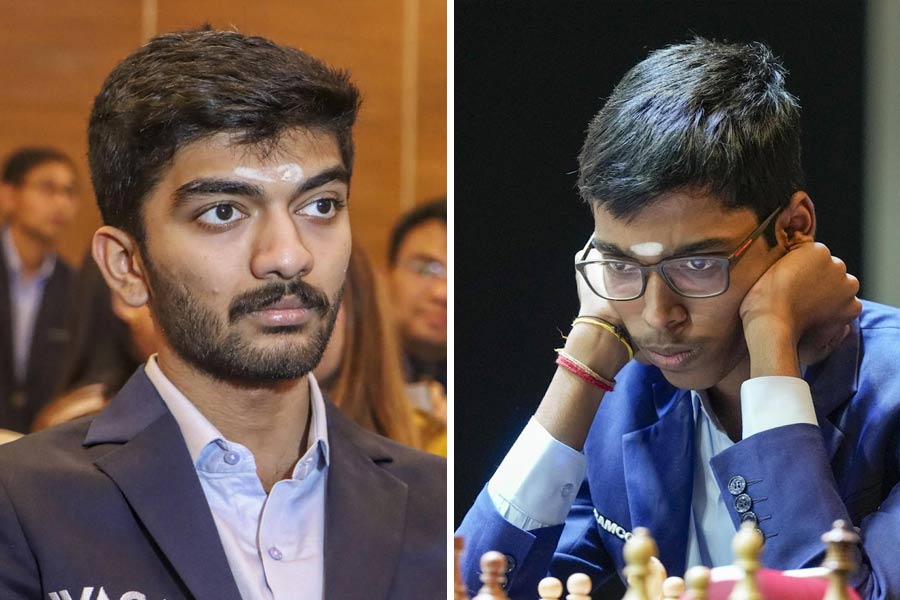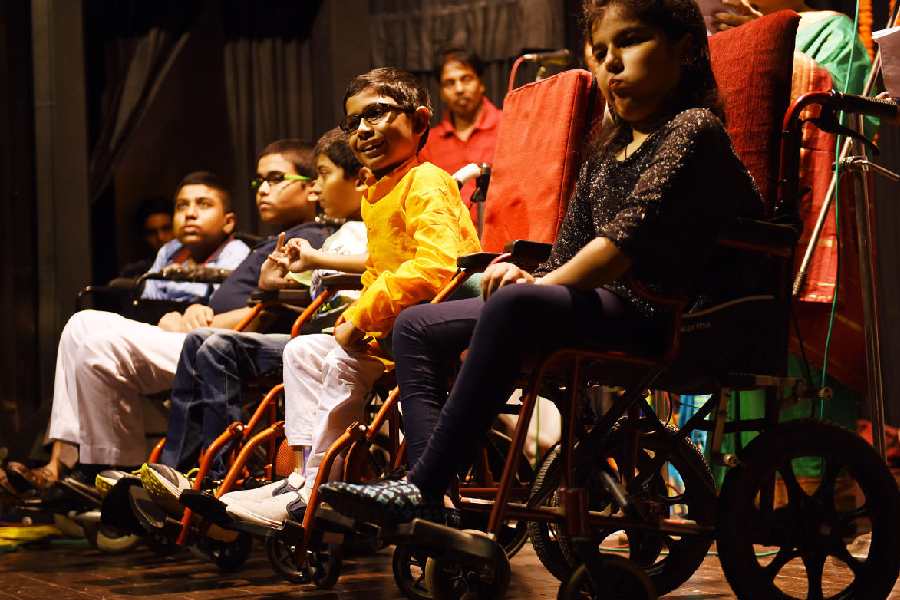Almost 70 years after his debut as a filmmaker, and in a year that celebrates 60 years of Guide, the cinema of Vijay Anand continues to resonate with film students and practitioners. On his 91st birth anniversary, Tanuja Chaturvedi, the author of Hum Dono: The Dev and Goldie Story, a tribute to one of the greatest actor-filmmaker collaborations, talks about Vijay Anand’s contribution to Indian cinema.
What is it that differentiated Vijay Anand from greats like Raj Kapoor, Guru Dutt and Bimal Roy who were at their peak when he started out in 1957?
Tanuja Chaturvedi: Unlike Raj Kapoor, Guru Dutt, Mehboob Khan and Bimal Roy, who came from small-town India, Goldie (Vijay Anand), though born in Gurdaspur, was brought up entirely in the cosmopolitan melting pot of Bombay. The cinema of Raj Kapoor, Guru Dutt, Mehboob Khan and Bimal Roy carry this texture of their early life visually, and in their songs, stories and characters. Goldie’s exposure was to the multiculturalism of Bombay, which shaped his intellect and vision differently.
There is a continuity in the other masters of the 1950s with the greats who preceded them. For instance, Guru Dutt is influenced by the great Gyan Mukherji. Bimal Roy carries the stylistic signatures of New Theatres in his films. Raj Kapoor apprenticed under Kidar Sharma and was shaped by his New Theatres’ influence. Goldie carries no such baggage. In that sense, he is a true original. By his own admission he was ‘allergic’ to the heavy melodramatic overtones in the contemporary films of those times.
Then comes Goldie’s song picturisations. In the films of the other greats of the era, many songs exist for their own sake, like the dazzling fantasy sequence in Ghar Aaya Mera Pardesi (Awara) that conveys the scale of the story. Right from his first film, Goldie’s brief to SD Burman was that his songs must move the story, or the characters’ emotional arc, or both. That if a song was taken out from his film, the audience should feel an absence.
As a student of cinema, what do you think is Vijay Anand’s defining contribution?
Tanuja Chaturvedi: Goldie is fascinating because he is a completely self-taught maverick. He is among a few in Indian and world cinema who displayed an amazing mastery over screenplay, dialogue, editing – the main crafts of cinema. He developed a wonderful eye for lensing. He wasn’t bogged down by film theory, so he was totally fearless. Songs then as now were cut on beat. Or a single line was one shot. He would break down one single line into several shots, each cutting together to create a seamless experience. This would later become his signature style.
The way his camera danced with the movement of actors was incredible. His infinitely complex camera movements never detracted from the story or the characters’ emotions. There is also the pace he sets from the outset. This pace resonates with us today with our ‘short attention’ spans. Watch any of his films and you are pulled into the heart of the film so economically. Not one shot is extraneous or for atmospherics.
As Sriram Raghavan pointed out, Goldie moves his films with an incredible pace but he knows where to have thehraav, that essential pause or breather that makes you feel and linger with a character. In Goldie you won’t notice the ‘cut’, the ‘shot’, as you are effectively taken into the hearts of his characters, their dilemmas, confusions, helplessness.
And yet, he was modesty personified. Only once did he say very matter-of-factly, ‘I changed the way dialogues will be written in Indian cinema with Guide forever.’ And that’s true. If you didn’t understand the nuances of his craft, it wouldn’t take away from the enjoyment of his films.
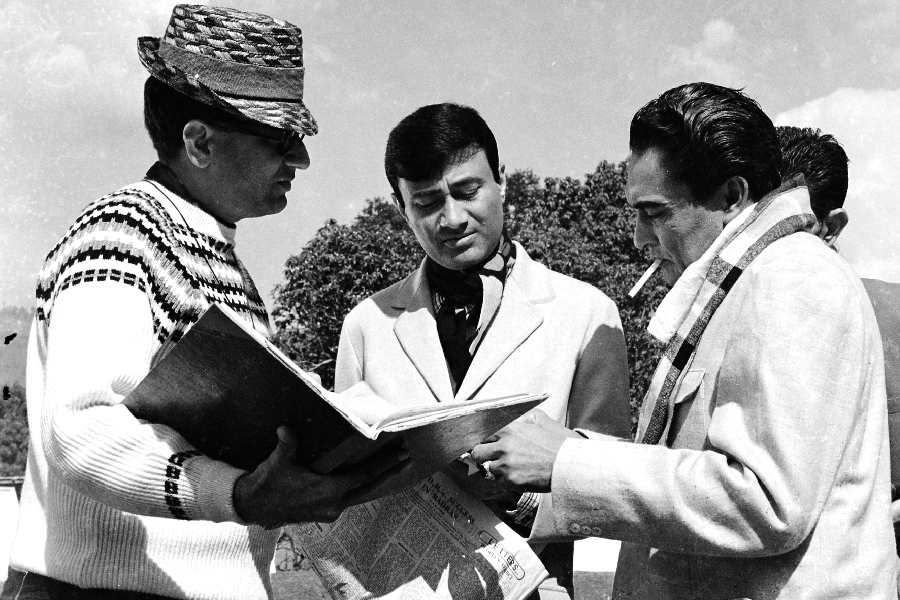
Vijay Anand with Dev Anand and Ashok Kumar on the set of 'Jewel Thief'
How do you think Vijay Anand’s song picturisation differed from those of his contemporaries?
Tanuja Chaturvedi: Look at the Indian dance numbers Goldie picturised; the virtuosity of Piya Tose Naina (Guide) or the fluidity of Hothon Mein Aisi Baat (Jewel Thief). Then see his picturisations for Western music, whether it’s Aaja Aaja Main Hoon (Teesri Manzil) or Baithe Hain Kya Uske Paas or Raat Akeli Hai (Jewel Thief).
First, the way Goldie uses cinema space. This is best exemplified by Dil Ka Bhanwar Kare Pukaar (Tere Ghar Ke Saamne). This journey up the steep Qutub Minar has Dev besotted by Nutan. Goldie takes an interesting cue from real life – the fact that this steep climb makes one feel dizzy and light-headed – like bees are buzzing in your head. With this cue SD Burman creates this buzzing with string instruments and the song, a love confession, starts. This evergreen song was shot on location and seamlessly melded with a set constructed of the Qutub interior. But in the ‘flow’ the audience doesn’t feel any jerk. This one song alone is a masterclass on mise-en-scene.
Now take Goldie into wide open spaces, or monuments. Like Nalanda for O Mere Raja (Johny Mera Naam) or Chittor for Kaanton Se Kheench Ke (Guide), an anthem of a woman’s liberation. In the latter song Goldie has the architecture in the background and he utilises the Victory tower, the alcoves, the dizzying height the heroine is at the risk of falling off from. Now let’s just constrict this space totally and we get Mile Do Badan (Blackmail). The situation for this song is so whacky. The husband and wife have not been able to come together due to misunderstandings. Now there are goons with guns and sniffer dogs after them. They are stuck inside a log stack, both facing opposite directions. And love ignites. Goldie cramps the actors and literally makes Dharmendra slide over Rakhee’s head to face her. Yet not once does the intensity of the situation abate.
Goldie creates other zany, unusual situations for songs in his films. They grow out of the spoken words of a dialogue. Take Apni To Har Aah Ek Toofan Hai (Kala Bazar). Goldie makes Waheeda Rehman occupy the top berth so that every time Dev Anand has to look at her, he has to look up. The dynamics of the relationship are simply stated. Since the heroine’s shocked parents are watching, and likely to assume the love song is being sung for their daughter, it is cheekily turned into a bhajan, and the ‘Ooperwala’ becomes the man in the skies.
Goldie understood when the song would work as an emotional release. This he does wonderfully in Nafrat Karne Waalon Ke (Johny Mera Naam). Dev has hatched a scheme with Hema Malini. A fight scene happens and the hero passes his last test of loyalty to Pran. The next morning as Hema walks to the parked truck, this sunny, gorgeous song just springs up between them and releases tension for the audience as much as Gata Rahe Mera Dil does in Guide. Every time I try to fast forward this song in my classes, because it doesn’t move the story, I am met with howls of protest. Yes, the beautiful location, the gorgeous stars, lovely clothes all are magical. But it is the only moment where the hero and the heroine, after going through so much strife and struggle, are happy and together. The audience wants to share their relief, savour their happiness. Now this sort of understanding by a director of what his audience will psychologically want is amazing.
This year marks 60 years of Guide, arguably Vijay Anand’s finest. Can you tell us how he made a film that stood apart from its source material?
Tanuja Chaturvedi: Goldie sahab had shared with me the real creative difficulty of making a film like Guide. The story moves on two different planes — the love story and the spiritual journey of Raju, who begins as a ‘fake’ swami. What Goldie achieves spectacularly in his screenplay is that he dispenses off with linearity. He actually begins the film where three-fourths of the novel and the English version of the film, which was faithful to the novel, are over. That’s a huge risk to take.
After the opening Wahan Kaun Hai Tera song, Raju reaches a village and the main body of the film starts as a flashback from Rosie’s point of view. For two and a half hours you are engrossed at the impossibility of the relationship between Rosie and Raju. The flashback ends, and with Raju’s mother’s query, ‘Jaane kis haal mein hoga mera beta?’, the audience suddenly realises that Raju had come out of the jail in the beginning of the film.
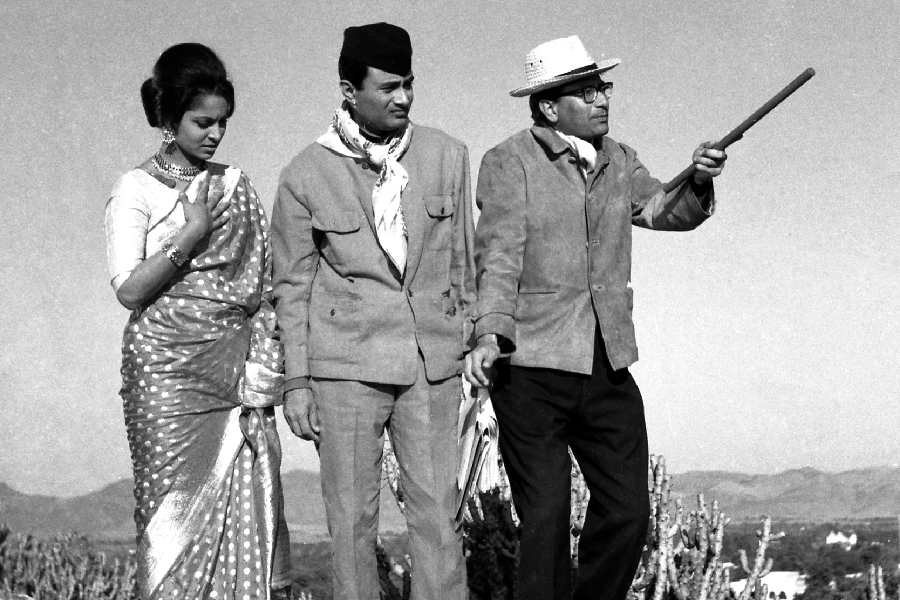
Waheeda Rehman and Dev Anand with Vijay Anand while shooting 'Guide'
Vijay Anand jumped genres with aplomb, from road movies to war movies to romcoms and thrillers…
Tanuja Chaturvedi: Goldie created the blueprint for thrillers and all swear by it. But his comedy, socials and love stories… all are wonderful. Look at Hum Dono, a film thematically about war and two soldiers, doppelgangers stuck in the senseless mayhem. But where does Goldie build the heart of his film? In the women, the mothers, the wife, the beloved, none of whom are directly involved in the war.
Consider Tere Ghar Ke Saamne, made at a time when our country’s morale was at an all-time low after the Chinese war. So what does Goldie do? He builds the film to a climax, talking about the ‘Chinese’ way to settle differences and the Indian way – the path of ‘Panchsheel’. The hero asks the burning question in the finale, ‘Kismet mein jiske pados mein rahna likha hai usse bhala bair kab tak? Nafrat se rahiyega to nafrat milegi, dosti kijiyega to dosti.’
Please shed some light on the Dev Anand-Vijay Anand collaboration. How did they feed off and influence each other?
Tanuja Chaturvedi: I guess in India we are reluctant to appreciate our own people. Goldie and Dev were working in the ‘popular’ space. Somehow the assumption was that lesser talent and artistry were needed within mainstream cinema. The brothers didn’t have to make an art film to prove their credentials. They were each other’s bouncing boards, creative collaborators. They shared the same genetic pool, values, ethics, taste. Dev sahab trusted Goldie implicitly. He valued Goldie’s intellect highly and allowed himself to be pushed in directions uncomfortable for him. With Dev, Goldie inherited one of the most good-looking actors ever. This in turn liberated Goldie’s inventive shot-takings tremendously.
They were also different personality types. Goldie was ‘goal-oriented’, which he had to be to achieve his vision and orchestrate a unit of hundreds of people. Dev was ‘process-oriented’ – he just loved the fact of creativity, of creating something where nothing was. If Dev was Goldie’s alter ego on screen, Dev’s philosophy of life, his positivity, his never-say-die spirit imbued Goldie’s heroes and his cinema. They completed each other.
Which is your favourite Vijay Anand film?
Tanuja Chaturvedi: Johny Mera Naam is brilliant. Goldie’s shot-taking, editing skills, and his witty dialogue writing come together for a phenomenal screenplay. It seems so simple and breezy on the surface but is so complex. Each character is memorable, down to the poor purohit whose daughter is kidnapped.
Initially Goldie didn’t feel any interest in this story, a fact he confessed to me. He was rather angry to be saddled with a mundane ‘lost and found’ story. But see how inventively he takes ‘lost and found’ in Johny Mera Naam and turns it into a cheeky potpourri of infiltration, romance, revenge, undercover operations and hidden agenda. And ultimately a sly game of wits! And then the brilliant five-act climax.
(Shantanu Ray Chaudhuri is a film and music buff, editor, publisher, film critic and writer)

